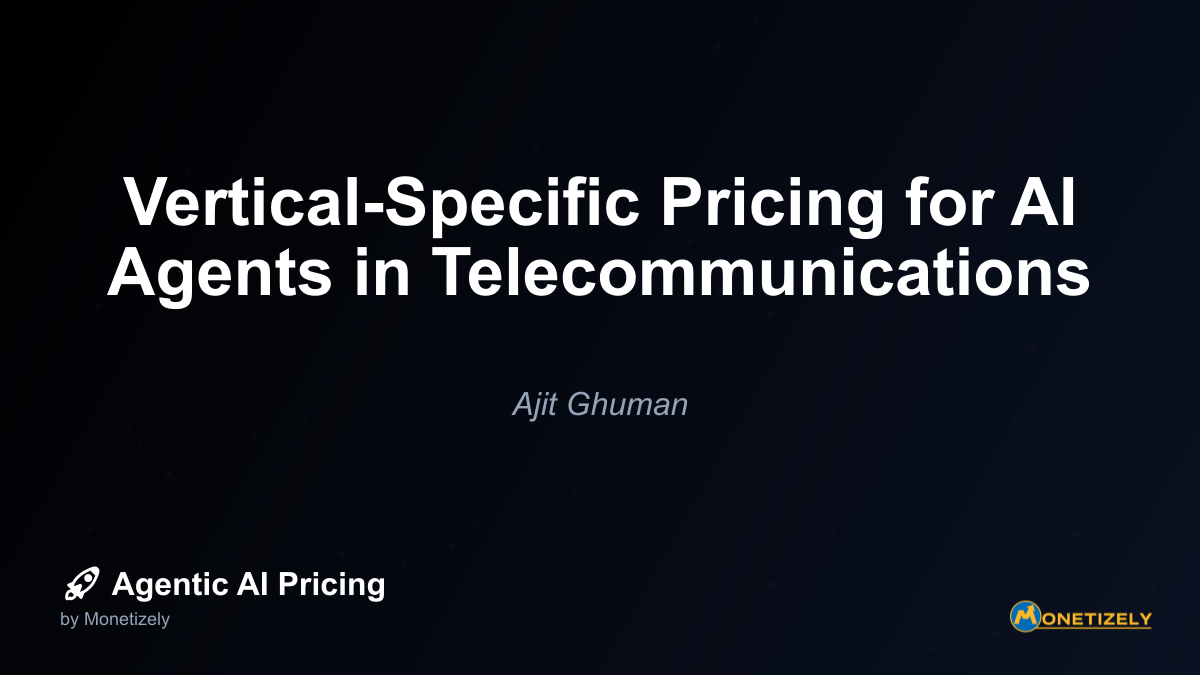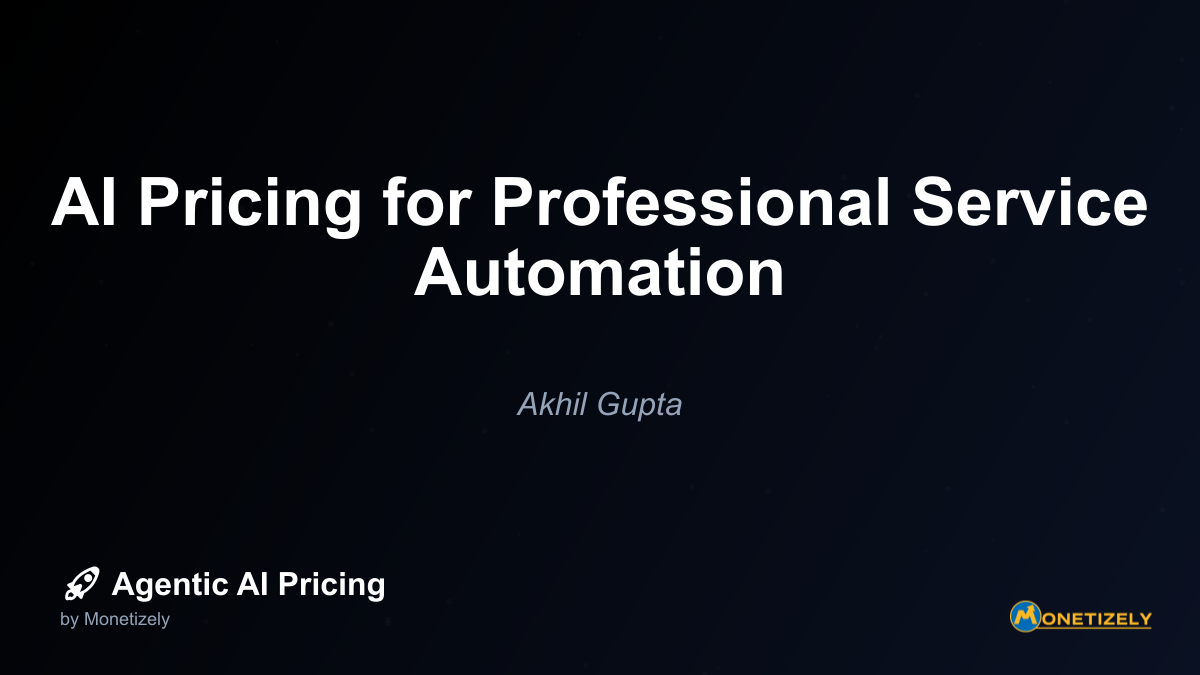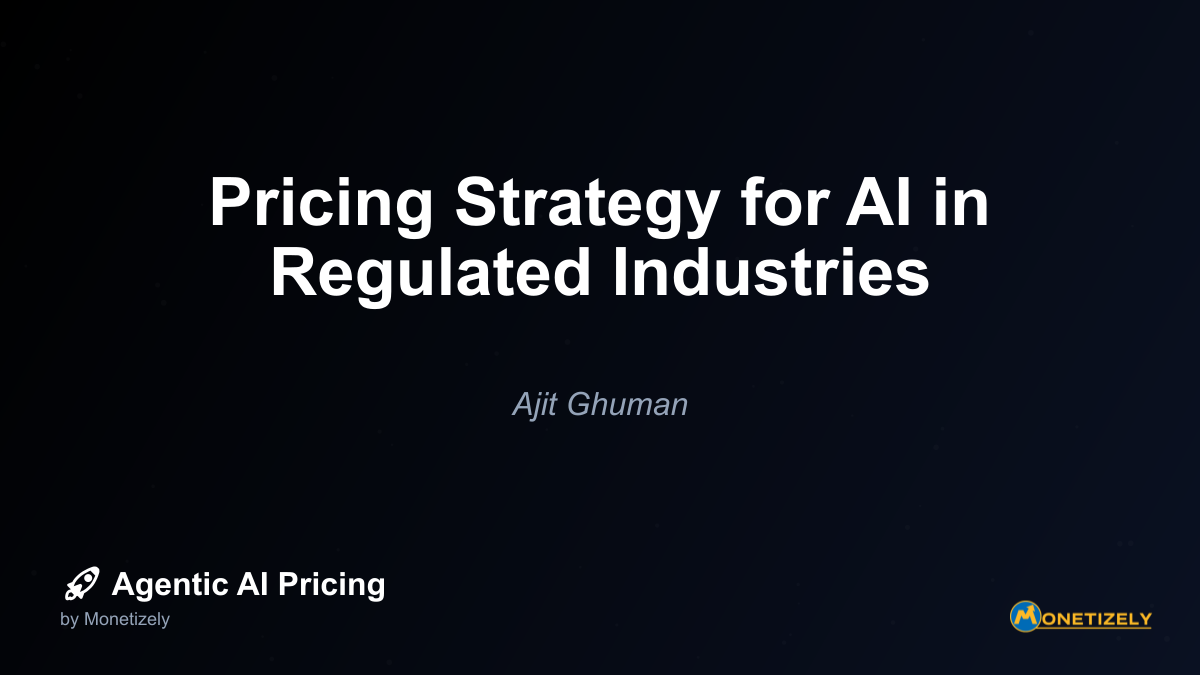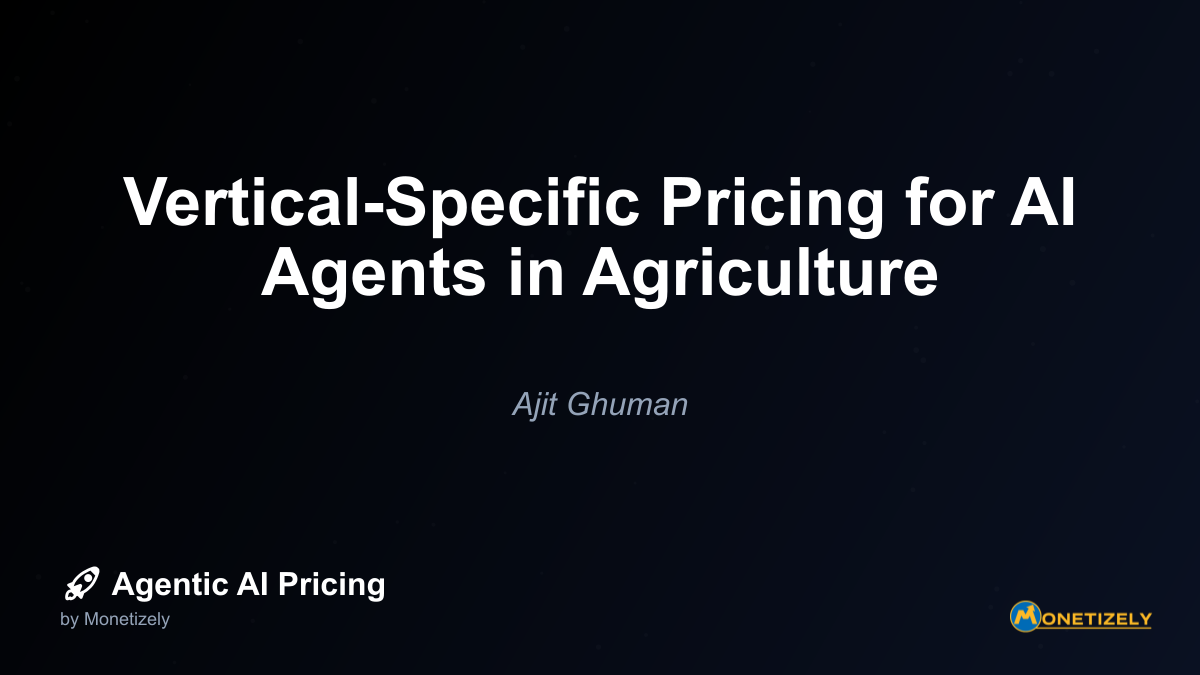· Ajit Ghuman · Industry-Specific · 11 min read
Vertical-Specific Pricing for AI Agents in Customer Service
AI and SaaS Pricing Masterclass
Learn the art of strategic pricing directly from industry experts. Our comprehensive course provides frameworks and methodologies for optimizing your pricing strategy in the evolving AI landscape. Earn a professional certification that can be imported directly to your LinkedIn profile.
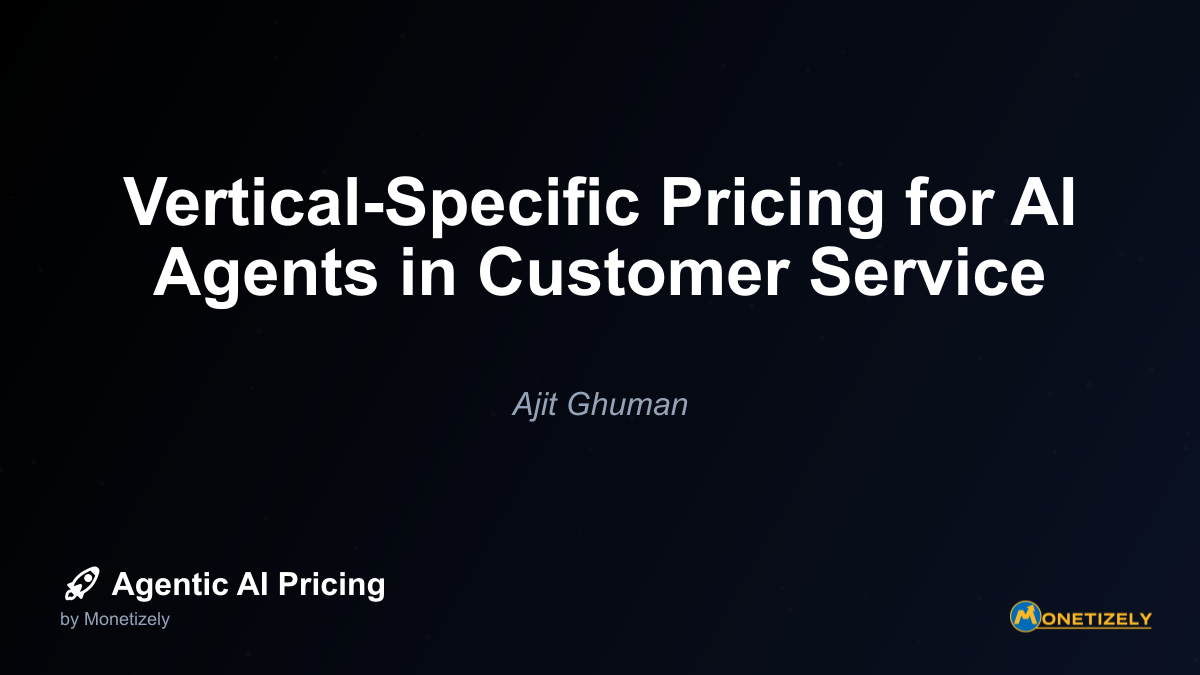
The evolving landscape of customer service has been dramatically reshaped by the integration of AI agents, creating new challenges and opportunities for pricing strategies. Traditional per-seat pricing models are rapidly becoming obsolete as organizations seek pricing structures that better align with the unique value proposition and economics of AI-powered customer service solutions. This shift demands a vertical-specific approach that accounts for the distinct needs, compliance requirements, and success metrics of different industries.
The Evolution of Customer Service AI Agent Pricing
Customer service AI pricing has undergone a significant transformation in recent years. According to recent market analysis, traditional seat-based pricing models have declined from 21% to just 15% of AI deployments between 2024 and 2025. This decline reflects a fundamental mismatch between static pricing structures and the dynamic, scalable nature of AI solutions.
Instead, the market is witnessing the rise of more sophisticated pricing models:
- Usage-based pricing: Charging based on actual consumption (API calls, tokens processed, compute time)
- Outcome-based pricing: Linking costs to measurable business results (tickets resolved, customer satisfaction improvements)
- Hybrid models: Combining base subscriptions with variable usage components
- Agent-based pricing: Charging per AI “agent” deployed, similar to human labor replacement costs
This evolution reflects a deeper understanding of AI’s economics. Unlike traditional software, AI customer service solutions have variable infrastructure costs that scale with usage, making static pricing models problematic for both vendors and customers.
The Economics of AI Customer Service
Understanding the unique economic factors driving AI customer service solutions is essential for developing effective pricing strategies:
Cost Structure Components
The cost structure of AI customer service agents differs significantly from traditional software:
- Infrastructure costs: Cloud computing, GPU resources, and data storage represent a substantial portion of expenses, directly tied to usage volume.
- Development and training costs: Initial AI model development and ongoing training require significant investment.
- Integration and customization: Adapting AI agents to specific customer service workflows adds implementation costs.
- Compliance and security: Particularly in regulated industries, ensuring data protection and regulatory compliance adds complexity and cost.
These costs create a fundamentally different economic profile compared to traditional software, with margins typically around 50-60% (below traditional SaaS margins of 70-80%) due to the variable infrastructure costs associated with AI processing.
Resolution Metrics and Their Impact on Pricing
Resolution metrics have emerged as critical factors in AI customer service pricing:
| Metric | Description | Pricing Implication |
|---|---|---|
| First Contact Resolution (FCR) | Percentage of issues resolved in a single interaction | Higher FCR justifies premium pricing |
| Average Resolution Time | Time taken to resolve customer issues | Faster resolution supports value-based pricing |
| Resolution Accuracy | Correctness of AI-provided solutions | Higher accuracy enables outcome-based pricing |
| Escalation Rate | Percentage of issues requiring human intervention | Lower rates demonstrate AI effectiveness |
These metrics directly impact the perceived value of AI customer service solutions and provide a foundation for outcome-based pricing models. For example, Intercom’s pricing model charges $0.99 per AI-resolved conversation, helping customers reduce support costs by 60% while tripling ticket handling capacity.
Vertical-Specific Pricing Considerations
Different industries have unique requirements that necessitate tailored pricing approaches for AI customer service solutions:
Retail and E-commerce
Key Characteristics:
- High volume of relatively simple, repetitive inquiries
- Seasonal fluctuations in demand
- Direct impact on sales conversion and cart abandonment
Pricing Model Preferences:
- Usage-based pricing aligned with transaction volume
- Outcome-based pricing tied to conversion improvements
- Tiered pricing based on interaction volume
Metrics That Matter:
- Customer satisfaction scores (CSAT/NPS)
- Cart abandonment rate reduction
- Upsell/cross-sell success rate
- First contact resolution rate
Example Pricing Structure: “Retail AI solutions often implement tiered usage pricing with seasonal flexibility. For instance, a major e-commerce platform charges a base subscription of $2,000/month plus $0.50 per AI-resolved inquiry, with volume discounts during peak seasons. This model reduced their support costs by 35% while maintaining a 92% customer satisfaction rate.”
Healthcare
Key Characteristics:
- Strict regulatory compliance (HIPAA, GDPR)
- Complex, high-stakes inquiries
- Enhanced security requirements
- Sensitivity around patient data
Pricing Model Preferences:
- Hybrid pricing with fixed compliance components
- Agent-based pricing reflecting specialized knowledge
- Premium pricing tiers for clinical vs. administrative support
Metrics That Matter:
- Compliance adherence
- Accuracy of information provided
- Patient satisfaction scores
- Proper escalation to human providers
Example Pricing Structure: “Healthcare providers typically adopt a hybrid model combining a higher base subscription ($5,000-$10,000/month) covering compliance and security costs, plus per-resolution fees for different inquiry types. Administrative inquiries might be priced at $1-2 per resolution, while clinical information requests command $5-10 per resolution due to their complexity and risk profile.”
Financial Services
Key Characteristics:
- Regulatory requirements (PCI-DSS, SOX, KYC)
- Complex product offerings
- High security needs
- Fraud detection capabilities
Pricing Model Preferences:
- Outcome-based pricing tied to fraud prevention
- Tiered pricing based on complexity of financial products
- Agent-based pricing for specialized functions
Metrics That Matter:
- Regulatory compliance
- Fraud detection rate
- Customer retention
- Successful transaction completion
Example Pricing Structure: “Financial institutions often implement multi-tiered pricing with outcome components. A major bank deployed an AI customer service solution with a base platform fee of $15,000/month plus performance-based charges: $0.75 per standard inquiry resolution, $2.50 per complex product inquiry, and a 0.01% fee on fraud prevented, aligning costs with measurable business outcomes.”
Telecommunications
Key Characteristics:
- Technical troubleshooting requirements
- High call volumes
- Complex billing inquiries
- Device-specific support needs
Pricing Model Preferences:
- Usage-based pricing aligned with call volume
- Outcome-based pricing tied to call deflection
- Hybrid models with fixed and variable components
Metrics That Matter:
- Call deflection rate
- First-call resolution
- Average handling time reduction
- Customer retention improvements
Example Pricing Structure: “Telecom companies typically adopt usage-based models with outcome incentives. A leading provider implemented a pricing structure with a $25,000 monthly platform fee plus $0.65 per resolved interaction, with a 15% discount on interactions that prevent a truck roll or technical dispatch. This model delivered a 3.2x ROI by reducing field service costs.”
Satisfaction Metrics and Pricing Alignment
Customer satisfaction metrics provide another dimension for vertical-specific pricing strategies. These metrics not only measure success but can be directly incorporated into pricing models:
Customer Satisfaction Score (CSAT)
CSAT measures immediate satisfaction following an interaction. Pricing models can incorporate CSAT in several ways:
- Performance bonuses: Additional fees when AI agents maintain CSAT above agreed thresholds
- Penalty structures: Reduced charges if satisfaction falls below targets
- Tiered pricing: Different rates based on satisfaction levels achieved
For retail and e-commerce, CSAT directly correlates with repeat purchases, making it a valuable pricing component. A major online retailer implemented a pricing model with a 10% premium for maintaining CSAT above 90%, resulting in both higher satisfaction and increased vendor margins.
Net Promoter Score (NPS)
NPS measures customer loyalty and likelihood to recommend. While less immediate than CSAT, NPS reflects longer-term relationship quality:
- Long-term contract incentives: Pricing discounts for sustained NPS improvements
- Success fees: Additional charges when NPS increases by agreed percentages
- Renewal incentives: Favorable terms for maintaining high NPS
In financial services, where customer relationships are particularly valuable, NPS-linked pricing has proven effective. One wealth management firm implemented a pricing structure that included a 5% quarterly bonus for NPS improvements, aligning vendor incentives with relationship quality.
First Contact Resolution (FCR)
FCR measures the percentage of issues resolved without follow-up or escalation:
- Per-resolution pricing: Higher fees for first-contact resolutions
- Escalation penalties: Reduced fees for issues requiring human intervention
- Volume incentives: Discounts for maintaining high FCR across large interaction volumes
In telecommunications, where repeat calls drive significant costs, FCR-based pricing delivers clear value. A major telecom provider implemented a pricing structure paying 2x the standard rate for first-contact resolutions, reducing overall support costs by 28% while improving customer satisfaction.
Implementation Framework for Vertical-Specific Pricing
Implementing an effective vertical-specific pricing strategy for AI customer service requires a systematic approach:
1. Assess Industry-Specific Value Drivers
Begin by identifying the unique value drivers in your industry vertical:
- Retail: Speed, conversion impact, seasonal flexibility
- Healthcare: Compliance, accuracy, appropriate escalation
- Financial Services: Security, fraud prevention, regulatory adherence
- Telecommunications: Technical resolution, call deflection, service appointment reduction
Understanding these value drivers provides the foundation for aligning pricing with customer outcomes.
2. Select Appropriate Pricing Metrics
Based on industry value drivers, select metrics that will form the basis of your pricing model:
- Usage metrics: API calls, tokens processed, interactions handled
- Outcome metrics: Resolutions achieved, conversions influenced, appointments scheduled
- Satisfaction metrics: CSAT, NPS, customer effort score
- Efficiency metrics: Resolution time, escalation rate, human agent time saved
The most effective pricing models typically incorporate multiple metric types to capture full value.
3. Design a Hybrid Pricing Structure
Create a pricing structure that combines fixed and variable components appropriate for your industry:
- Base platform fee: Covers fixed costs, compliance, security, and basic functionality
- Usage components: Reflect variable infrastructure costs associated with AI processing
- Outcome incentives: Align pricing with successful business outcomes
- Performance adjustments: Modify pricing based on satisfaction and quality metrics
This hybrid approach balances predictability with value-based pricing principles.
4. Implement Transparent Measurement
Establish clear measurement protocols for all pricing components:
- Usage dashboards: Real-time visibility into consumption metrics
- Outcome tracking: Agreed methodologies for measuring business results
- Satisfaction monitoring: Regular assessment of customer experience
- Cost transparency: Clear attribution of charges to specific activities
Transparency builds trust and reduces friction in value-based pricing models.
5. Pilot and Refine
Begin with a pilot implementation to validate your pricing approach:
- Select representative customers: Choose early adopters willing to provide feedback
- Set initial pricing: Establish baseline pricing with adjustment mechanisms
- Gather feedback: Collect detailed input on pricing structure and value perception
- Iterate quickly: Refine the model based on real-world performance
Pilots provide essential validation before full-scale deployment.
Case Studies: Successful Vertical-Specific Pricing
Retail: Major E-commerce Platform
Challenge: Seasonal fluctuations in support volume created unpredictable costs under traditional pricing models.
Solution: Implemented a usage-based pricing model with seasonal flexibility:
- Base platform fee: $2,500/month
- Standard resolution: $0.45 per interaction
- Complex resolution: $1.20 per interaction
- Seasonal discount: 20% volume discount during peak periods
- CSAT bonus: 10% premium for maintaining satisfaction above 92%
Results:
- 35% reduction in overall support costs
- 28% increase in first-contact resolution
- 92% customer satisfaction maintained during peak seasons
- Predictable costs aligned with business cycles
Healthcare: Regional Hospital Network
Challenge: Needed to balance strict compliance requirements with cost-effective patient support.
Solution: Deployed a hybrid pricing model with compliance-focused components:
- Compliance base fee: $8,500/month (covering HIPAA, security, audit trails)
- Administrative inquiries: $1.25 per resolution
- Clinical information: $6.50 per resolution
- Escalation guarantee: No charge for interactions requiring clinical staff intervention
- Accuracy SLA: 99.5% information accuracy with financial penalties for errors
Results:
- 42% reduction in administrative staff time
- 22% improvement in patient satisfaction
- Zero compliance incidents over 18 months
- $1.2M annual savings in support costs
Financial Services: Global Banking Institution
Challenge: Needed to improve customer service while maintaining security and compliance.
Solution: Implemented an outcome-based pricing model focused on business results:
- Platform fee: $15,000/month
- Standard inquiries: $0.95 per resolution
- Complex product inquiries: $2.75 per resolution
- Fraud prevention: 0.015% fee on fraud prevented
- Retention bonus: $50 per customer retained when flagged as at-risk
Results:
- 60% reduction in query handling time
- 28% improvement in customer retention
- $4.2M in prevented fraud in first year
- 3.8x ROI on AI customer service investment
Future Trends in Vertical-Specific AI Pricing
The future of vertical-specific pricing for AI customer service is being shaped by several emerging trends:
Intelligent Dynamic Pricing
AI itself is enabling more sophisticated pricing models that adjust in real-time based on:
- Demand patterns: Pricing that flexes with customer support volume
- Complexity detection: Automatic adjustment based on inquiry difficulty
- Value prediction: Algorithmic assessment of potential business impact
- Resource optimization: Pricing that incentivizes efficient AI utilization
These dynamic models will allow more precise alignment between cost and value across different industry verticals.
Integration of External Data Sources
Pricing models are increasingly incorporating external data to enhance value alignment:
- Industry benchmarks: Pricing adjusted based on comparative performance
- Economic indicators: Models that reflect broader business conditions
- Customer lifecycle data: Pricing that considers customer lifetime value
- Competitive intelligence: Adjustments based on market positioning
This integration enables more sophisticated value-based pricing tailored to specific industry contexts.
Ecosystem-Based Pricing
As AI customer service becomes part of broader ecosystems, pricing is evolving to reflect this integration:
- Platform economics: Pricing that captures network effects across customer bases
- Integration incentives: Models that reward connectivity with other systems
- Data network effects: Pricing that reflects the value of aggregated insights
- Cross-vertical applications: Flexible models that span multiple industries
These ecosystem approaches recognize that AI value often transcends traditional industry boundaries.
Regulatory-Aware Pricing
Emerging regulations around AI are influencing pricing structures:
- Compliance premiums: Higher pricing for solutions meeting stricter regulatory standards
- Transparency requirements: Models that explicitly separate infrastructure from value components
- Data governance costs: Pricing that reflects the expense of proper data handling
- Ethical AI premiums: Higher rates for solutions demonstrating responsible AI principles
These regulatory considerations will become increasingly important differentiators across verticals.
Conclusion: Building a Sustainable Vertical-Specific Pricing Strategy
Creating an effective vertical-specific pricing strategy for AI customer service requires balancing multiple factors:
Align with industry value drivers: Understand what matters most in your specific vertical and build pricing around these priorities.
Balance predictability and flexibility: Combine fixed and variable components to provide budget certainty while capturing value.
Incorporate relevant metrics: Use industry-specific resolution and satisfaction metrics to create meaningful outcome-based pricing.
Ensure transparency: Provide clear visibility into both usage and outcomes to build trust and demonstrate value.
Evolve continuously: Recognize that AI capabilities and customer expectations will continue to evolve, requiring ongoing pricing innovation.
By embracing these principles, organizations can develop vertical-specific pricing strategies that accurately reflect the unique value of AI in customer service while ensuring sustainable economics for both vendors and customers.
The transition from generic, one-size-fits-all pricing to sophisticated vertical-specific models represents a maturation of the AI customer service market. As these solutions become increasingly specialized and integrated into core business operations, pricing strategies that accurately reflect their distinct value in different industry contexts will become a critical competitive differentiator.
Organizations that successfully implement vertical-specific pricing aligned with resolution metrics and satisfaction outcomes will not only capture fair value for their AI solutions but will also build stronger, more sustainable customer relationships based on shared success and measurable business impact.
Finding the right balance between resolution rates and interaction volume remains a critical challenge for optimal AI customer service pricing. By adopting a vertical-specific approach that accounts for the unique characteristics of each industry, companies can develop pricing strategies that better align costs with value and drive successful AI adoption across the customer service landscape.
Co-Founder & CEO
Ajit is the author of Price To Scale, a top book on SaaS Pricing and is the Founder of Monetizely. Ajit has led and worked in pricing and product marketing at firms like Twilio, Narvar and Medallia. His work has been featured in Forbes and VentureBeat. Ajit regularly consults with software companies from Seed stage to post-IPO on pricing strategy. Ajit is also a highly-rated co-instructor for 'The Art of SaaS Pricing and Monetization' on Maven.
Pricing Strategy Audit
Let our experts analyze your current pricing strategy and identify opportunities for improvement. Our data-driven assessment will help you unlock untapped revenue potential and optimize your AI pricing approach.

